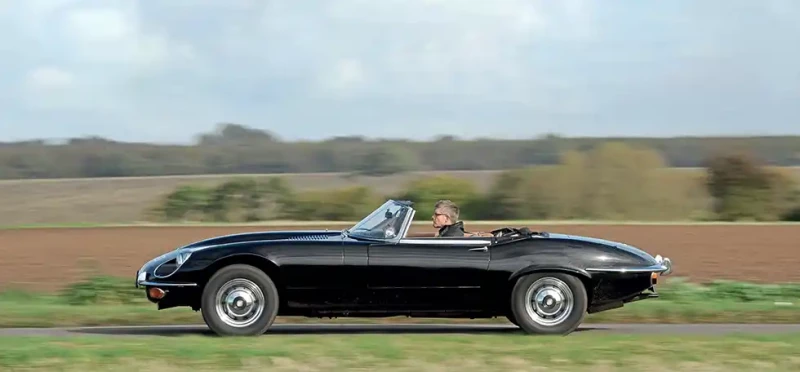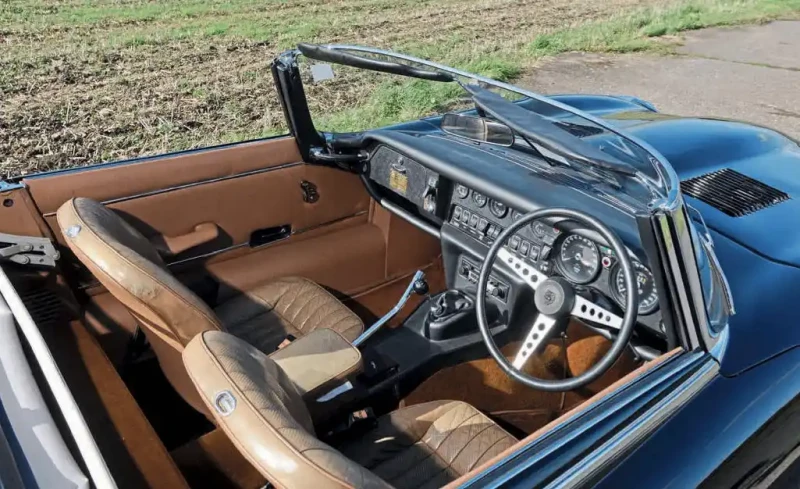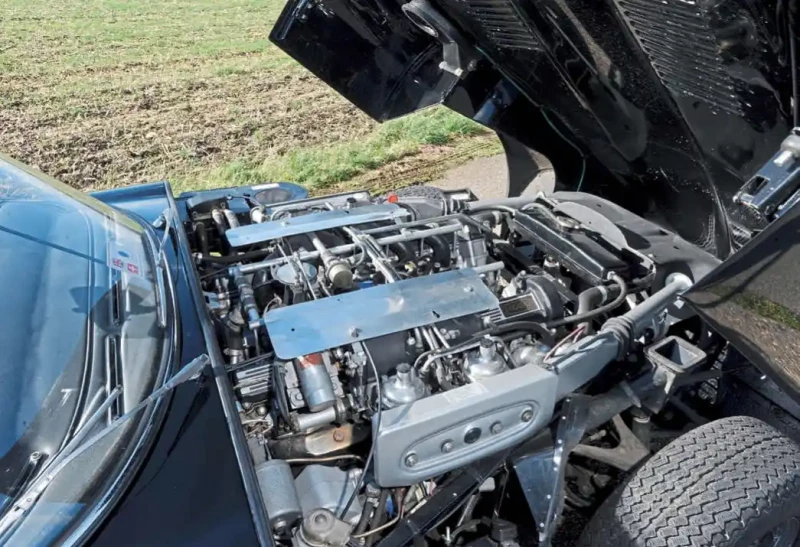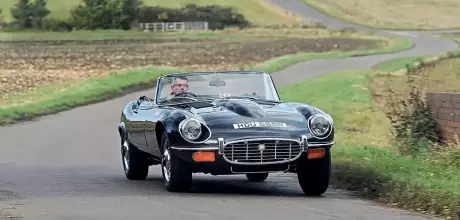Final 1974 Jaguar E-Type, chassis 1S/2872
Not only is the final E-Type the last example of this iconic model but it also represents an end of an era for Jaguar. To mark the 50th anniversary of its assembly, we look at the car’s background before explaining its place in the company’s history.
WORDS PAUL WALTON
PHOTOGRAPHY MICHAEL BAILIE
THE FINAL E-TYPE We look back, 50 years on

When the final E-Type, chassis 1S/2872, slowly rolled down the Browns Lane assembly line on 12 June 1974, with its bonnet raised it looked like a mourner bowing its head. It’s certainly how those who built the car must have felt. It’s not unusual for a production car to come to an end especially after 13 years like the E-Type. But the final example of this iconic model was still a significant moment in Jaguar’s long history. As arguably one of the prettiest sports cars ever designed, it became Jaguar’s most famous model and helped solidate its position as a major player in the European car market. Together with the miniskirt, the Mini and The Beatles, the car had also come to define the 1960s. «It is impossible to overstate the impact the E-Type had when it was unveiled in 1961,» explained Jaguar’s former design director, Ian Callum, for the car’s 50th anniversary. «Here was a car that encapsulated the spirit of the revolutionary era it came to symbolise.»

Plus, as the final E-Type it also makes it the last genuine Jaguar sports car until the F-TYPEww arrived four decades later.
If cars were art, it makes this particular one as important as the final painting by Leonardo orMonet. Yet this wasn’t always the case.
The Е-Type was updated twice in its lifetime, largely cosmetically in 1968 and more significantly three years later when Jaguar's then new 5.3-litre V12 replaced the 4.2-litre straight six. The open-two-seater also used the same longer chassis as the 2+2 fixedhead coupe creating more legroom. Although with 272bhp the V12 made it an undeniably a powerful sports car, it perhaps lacked the sharpness both visually and dynamically of the earlier versions.

«I thought the Е-Type went down the drain [with the Series 3],» said Jackie Stewart, who had started his racing career driving a Series 1, in Philip Porter's seminal 1989 tome, Jaguar Е-Type The Definitive History. «I thought they had lost their currency. When they started raising the windscreen and then putting the V12 in, I thought the car's character had been bastardised. I thought it lost its elegance, it lost its chicness, it lost everything.»
But not only had the Е-Type changed by the early Seventies, but so had the sports car market. America was now looking at ultimately unrealised legislation that would have outlawed convertibles plus customers were wanting comfort and luxury not the cold, basic and draughty sports cars from the past. It's why Lotus replaced the Elan with the more upmarket Elite in May 1974 and why Triumph introduced the originally coupe-only TR7 a few months later. It also explains why companies that didn't react to this changing market such as MG eventually went under.
Despite its now iconic status, the E-type didn't escape this. As proof of how unpopular the car had become, when I spoke to former Jaguar test driver, Ed Abbot, in 2015, he remembered changing the spark plugs on 200 unsold Е-Type Series 3s that were stored at Coventry airport because nobody wanted them.
«I loved Е-Types,» said Jaguar's then managing director, Frank 'Lofty' England in Porter's book, «but it had its deficiencies. People don't realise how operating conditions have changed since 1961. Traffic is now so appalling and you spend half your time sitting in a traffic jam. If you're sitting in traffic, you need some room to improve and you need a proper, decent air conditioning system. The Е-Type hadn't got it.»
Ventilation was just one of the ways the now decade old car was being left behind by the more modern competition. «One of the biggest failings of the E-Type,» continued England, «was the fact you hadn't got enough room in the scuttle to get a decent air conditioning set up there, which is pretty vital.»
As the Australian magazine, Modern Motor, said in its June 1972 test of a Series 3, “It has a ventilation system which would have been out of place in a mass-produced car of the late Fifties. It is dreadful.” This is why Jaguar developed its own grand tourer, the eventual XJ-S, that due to its size, luxurious interior and air conditioning made it a very different beast to its predecessor.
And so time was finally called on the E-Type. The final 2+2 FHC left the production line in October 1973. Although this gave the roadster a temporary boost in sales, by June the following year it too came to an end.
Forty-nine of the final 50 cars were all painted black (the second to last one was a special order by a well-known Jaguar private collector in British Racing Green) with steel wheels and a black vinyl roof while the upholstery was tan. On the lefthand- side of the dashboard was a brass plaque explaining it was one of the final 50 plus a facsimile of the signature of Jaguar’s founder and now president, Sir William Lyons. Together, these final 50 cars are now unofficially known as the Commemorative Edition models.
The last example followed this specification but the plaque now read; “This is the final car built after 13 years of Jaguar E Type Sports Cars.”
As an important part of the company’s history, the car was retained by the company, spending its early years in a small showroom on the ground floor of the main Browns Lane office block. It was only registered HDU 555N the following February, a number it still has.
After its formation in June 1983, the final E-Type was then gifted to the Jaguar Daimler Heritage Trust. With the organisation never afraid to use its collection, this still important car is regularly seen and enjoyed at shows across the globe. It also gives journalists like me access to the car for features.
I’ve driven the black E-Type Series 3 several times over the years, the first being in 2001 when I drove it and the earliest known E-Type open-two-seater, 77RW, to Geneva as part of an event to mark its 40th anniversary. More recently, in 2021 I took it up the famous Shelsley Walsh hillclimb for the E-Type Club’s celebrations to mark the car’s 60th.
Together with only covering 50k miles plus being recommissioned by the Trust a couple of times, the otherwise largely original car is in a beautiful condition. Although Series 3s clearly lack the svelteness of the earlier models, thanks to the track being wider than that of the Series 1 (11cm at the from, 7cm at the rear) plus flared wheel arches together with the large eggcrate grille, I reckon the car has a tougher stance than the arguably more feminine early models.
Although not as spacious as the XJ-S, thanks to the longer chassis neither is it as leg-numbingly cramped as the Sixties original. The interior is largely as per the Series 2; classic white on black dials set directly into the dash plus a row of rocker switchers in the centre console. A classic look now, there’s no denying it must have looked old fashioned compared to new models such as the Ferrari 308 GTB that had the speedo, rev counter and auxiliary dials set into a binnacle in front of the driver.
If you can forget about its significance on Jaguar’s history for a moment or that it feels like taking the Monet’s final depiction of waterlilies for a spin, like all Series 3s, the final E-Type is beautiful to drive. The big V12 might lack the aural excitement of other iconic engines such as Ferrari’s Dino 2.9-litre V8 or Lamborghini’s 3.9 V12 but squeeze the throttle and not only is its acceleration sharp and instant, but it’s smoother than late night jazz. Due to being around 23cm longer than the earlier open-two-seaters due to its 2+2 chassis, the Series 3 was the only E-Type convertible to have the option of an automatic, Borg Warner’s dim-witted three-speeder. Thankfully the final car has Jaguar’s own four-speed manual transmission and although the throws between each gear are longer than the bonnet, it still clicks cleanly into position, further aiding the rapidity of the car’s progress.
The fingertip light steering might be overly assisted for a sports car, but it does mean the Series 3 is easier to manoeuvre at slow speeds than the earlier straight-six models that lacked PAS. But due to it’s still being accurate together with perfectly controlled body roll the car has a similar sharpness to the Series 1.
There’s no denying that as the final E-type, 1S/2872 is an important moment in Jaguar’s history. But thanks to the way it drives, at its heart it remains the perfect example of this now popular sports car.


